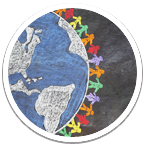Different types and resulting health harms
The World Health Organization (2008) classifies female genital mutilation (female circumcision) into four main groups:
- Type I: Removal of the clitoral glans and/or clitoral hood.
- Type II: Removal of the clitoral glans and labia minora with or without removal of the labia majora.
- Type III: Removal of the labia minora and/or labia majora and narrowing of the vaginal opening through the creation of a covering seal so that only a small opening is left for the passage of urine and menstrual blood. The clitoral glans may be removed or left under the fold of skin covering or restricting the vaginal opening. This procedure is also called infibulation or Pharaonic circumcision.
- Type IV: All other measures that harm women's genital organs for non-medical reasons. These include pricking, piercing, incising, scraping and cauterizing the genital area.
In practice, however, it may be difficult to distinguish between genital mutilation types, as different mixed forms are common.
Deinfibulation refers to the operation to open the vagina, for example during labour, in which the joined labia are opened up.
Reinfibulation refers to stitching the labia together again, for example after delivery. Reinfibulation is not carried out in Finland, only measures to repair damage from the birth process.
Health harms
The genital mutilation of girls and women has no health benefits, but instead causes a wide range of physical and psychological health problems. The nature and extent of these is affected by factors such as who carries out the FGM, the way it is done, the extent of it, and the surgery conditions. FGM carried out in primitive and unhygienic conditions is likely to cause more serious health damage than FGM done in hospital conditions.
Immediate complications
- Pain: shock
- Bleeding (abundant or prolonged): anaemia, drop in blood pressure, shock, death,
- Urinary problems: damage to urethra, inability to urinate, urinary tract infection
- Infections: wound infection, pelvic infection, blood poisoning, tetanus, viral infections (e.g. hepatitis B and C, HIV), septic shock, death
- Damage to other tissues and organs during genital mutilation
- Bone fractures or dislocation of joints while being restrained
- Psychological problems: fear, stress, nightmares
Long-term complications
- Pain: menstrual pain, pain during urination and intercourse
- Urinary problems: urinary tract infections, incontinence, urinary stones
- Consequences of scarring: retention of menstrual blood in the vagina, cysts and abscesses in the external genitals, neuromas, keloids, tissue rigidity, fistulae of the bladder and intestine, difficulties in carrying out gynaecological examinations
- Fertility and sex: fear of intercourse, intercourse pain, inability to engage in intercourse due to sewn up genital organs, orgasm problems, infertility
- Psychological problems: post-traumatic stress disorder, nightmares, loss of sleep, eating disorders, cognitive disorders, low self-esteem, anxiety, depression
- Other consequences: chronic infections (e.g. hepatitis B and C, HIV)
Problems related to childbirth
- Difficulty in monitoring the foetus and the progress of labour
- Prolonged second stage
- Tearing: bleeding, infections (risk of tetanus, blood poisoning, etc. if taking place in primitive conditions)
- Episiotomy
- Caesarean sections
- Transmission of chronic infections from mother to child (e.g. hepatitis B and C, HIV)
- Psychological problems: fear of childbirth, flashbacks to the moment of genital mutilation, reluctance to give birth again
.jpg/b757e827-68b0-6a8a-2c7a-6628cf451713?t=1737470530837)
Prevention of female genital mutilation (FGM)
Prevention of female genital mutilation (FGM) (Amharic)
Prevention of female genital mutilation (FGM) (Arabic)
Prevention of female genital mutilation (FGM) (Dari)
Prevention of female genital mutilation (FGM) (Persian)
Prevention of female genital mutilation (FGM) (French)




